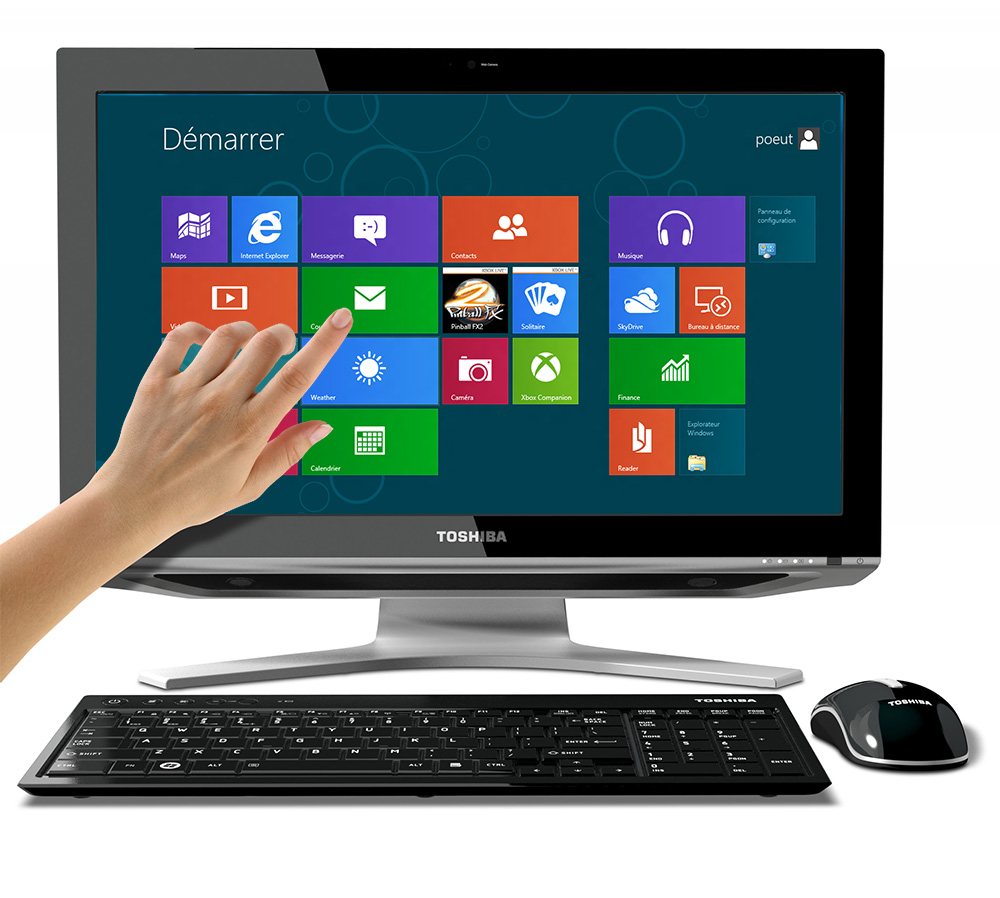Lenovo: PC Industry Underestimated Demand for Touch
The industry missed the boat in regards to predicting the current craze for touch-based desktops and laptops.
In a recent interview with CNET, Lenovo's president of the North American region, Gerry Smith, said that the PC industry underestimated the popularity of touch.
The news is a little surprising given that a good number of the computing public uses a touch-based smartphone, tablet ot handheld console. The obvious desire to manipulate images, apps and other virtual objects with a fingertip should be seemingly clear, a trend that Microsoft even sniffed out and focused on when developing Windows 8. Trouble is, you'll be hard pressed to find a desktop or laptop that actually supports touch on the market today.
Naturally the cost of adding touch-based capabilities has been a huge factor for manufacturers, but prior to the launch of Windows 8, there was also a general consensus that there simply wasn't a huge demand for touchscreens. But the industry was wrong, and the immediate high demand for touch-based desktops and laptops has left OEMs unable to keep up with the demand.
Up until October 26, the industry was hoping that the launch of Windows 8 would reinvigorate the PC market. But according to NPD, sales of Windows-based devices actually dropped 21-percent during the initial four-week launch compared to the same time period in 2011. On the other hand, touchscreen desktop sales are actually doing better than expected, but the numbers are limited because vendors weren't prepared for the high demand.
"As you go through any major architectural transition, you try to forecast accurately how much the attach rate will be on touch [or other features]," Smith said. "Across every major [shift] over the past 10 years, we're never right. The learning is, how do you respond to that? How does the industry change and evolve?"
Moving forward, he said the industry will have to determine how "off" it was about the demand for touchscreens, and to figure out what it can do to prevent a similar scenario in the future. Smith said the touch panel supply is improving, and more touch capacity should be available in the first half of 2013 to help meet consumer demand.
Smith also noted that this improvement in supply is crucial, and more and more computers will likely switch over to touch-based panels. Even Lenovo predicts that 50-percent of its desktops and laptops – excluding tablets and smartphones – will sport touchscreen within the next two or three years.
Get Tom's Hardware's best news and in-depth reviews, straight to your inbox.
Missing the touch-based forecast was actually great news, he said, because if touch turned out to be a disaster, then OEMs would have had a frightening stockpile of unsold products. "I view it selling well, a shortage, everyone chasing supply as a huge positive because it shows market potential and it shows a huge market opportunity," Smith said.
Despite the current supply shortage, Smith said that Lenovo is experiencing strong sales of its non-touch PCs. Even more, he's noticed that sales of premium-priced computers are growing faster than other PC segments. Lenovo is a little different than the others, he said, an anomaly in the global PC market thanks to its high exposure in China.
While the company has consistently been gaining market share, competitors like HP and Dell have pulled back, CNET reports. Currently Lenovo is pegged as the largest PC vendor on the planet (although IDC disagrees, favoring HP), and the company is looking to dominate the North American market as well.

Kevin Parrish has over a decade of experience as a writer, editor, and product tester. His work focused on computer hardware, networking equipment, smartphones, tablets, gaming consoles, and other internet-connected devices. His work has appeared in Tom's Hardware, Tom's Guide, Maximum PC, Digital Trends, Android Authority, How-To Geek, Lifewire, and others.
-
matt_b Consumer: Microsoft overestimated the PC industry's demand for touch with Windows 8.Reply
"Touch" devices have their role and it's still the new thing out there. Sales should be strong for sometime. Power users, IT, and gamers want nothing of it and I feel that due to this current fad explosion, the rest of the market moved too fast and left the actual base of the "non-touch" users out in the cold. It's a split market, it's a shame that the actual PC users here got shafted so fast - not everyone wants or can utilize a Surface, Kindle, Ipad, etc. -
YardstickWHACK matt_bConsumer: Microsoft overestimated the PC industry's demand for touch with Windows 8. "Touch" devices have their role and it's still the new thing out there. Sales should be strong for sometime. Power users, IT, and gamers want nothing of it and I feel that due to this current fad explosion, the rest of the market moved too fast and left the actual base of the "non-touch" users out in the cold. It's a split market, it's a shame that the actual PC users here got shafted so fast - not everyone wants or can utilize a Surface, Kindle, Ipad, etc.This is precisely why Windows 8 is selling poorly. In contrast, touch hardware is also very much in demand because someone looking to buy a new computer can not find Windows 7 very easily. This them leads them to wonder why they would purchase a computer with Windows 8 and not get touch capabilities. "Touch" is not in demand, just the hardware because people are being force-fed touch software.Reply -
Onus ^Exactly. Touch is for smartphones, tablets, and other handheld devices, not at all for PCs.Reply -
Parsian If I am going to use Win8, I want to have touch capability on my form factor "." Give me a Surface Pro like device with touch+stylus capability, and I will be all over it. Ive been using Tablet PC's for a while and I cannot find a substitute other than another Tablet PC (touch would be a bonus just as better batter and more portability are always welcome)Reply
-
bllue matt_bConsumer: Microsoft overestimated the PC industry's demand for touch with Windows 8. "Touch" devices have their role and it's still the new thing out there. Sales should be strong for sometime. Power users, IT, and gamers want nothing of it and I feel that due to this current fad explosion, the rest of the market moved too fast and left the actual base of the "non-touch" users out in the cold. It's a split market, it's a shame that the actual PC users here got shafted so fast - not everyone wants or can utilize a Surface, Kindle, Ipad, etc.It's just in their best interest to market to the majority. No one should be shocked that power users and gamers get "shafted." Why market to a few dozen millions when you could do it for hundreds of million?Reply -
bystander I most definitely believe this will be true. For starters, laptops have always been a pain in the butt to use with their touchpad. It works, but touch will be a huge improvement and my next laptop/convertible will definitely have touch.Reply
Then you have a lot of users who have computers and laptops that see no reason to upgrade unless they gain something new. That is where touch screens come in. Touch screens give the consumer a reason to buy a new computer, even if they didn't need it, they see it as something they would like to have. -
This guy must be retarded! People do NOT want to use their fingertips for direct interface with everything! This is why we started out with switches, knobs, then keyboards and a mouse. This is why we've stuck with the Keyboard and mouse for decades. Touch screens of many varieties have been around for decades as well, and they have PROVEN to be useless for desktop computing. They are inaccurate, messy (finger prints / dirt on screen), and an annoyance. Where a touch interface has been needed, they have been built in the past. Light pens for radar operators for example, or touch sensitive pens for artists, but that's where they'll stay, PERIOD!Reply
-
bystander JustPosting94This guy must be retarded! People do NOT want to use their fingertips for direct interface with everything! This is why we started out with switches, knobs, then keyboards and a mouse. This is why we've stuck with the Keyboard and mouse for decades. Touch screens of many varieties have been around for decades as well, and they have PROVEN to be useless for desktop computing. They are inaccurate, messy (finger prints / dirt on screen), and an annoyance. Where a touch interface has been needed, they have been built in the past. Light pens for radar operators for example, or touch sensitive pens for artists, but that's where they'll stay, PERIOD!You can't lump everyone into your box. People said the same thing about the first iPhone, look how that turned out. Laptops desperately need improvement on their input device and I do know non-enthusiasts who have gone for touch PC's, that are quite happy with their choice.Reply
I agree that I am not ready for move to a touch screen PC, but that doesn't mean Joe public is not going to want to move to one. It is one of the few things that would motivate Joe public to go out and upgrade a working PC. -
meluvcookies The real problem is that MS could have produced a OS that offered two fully realized UIs without the obvious compromises (or laziness, depending on your perspective) that we see in Win8. Had they done this, then it wouldn't matter whether your platform is a non-touch laptop, a touch (or convertible laptop/tablet, or dedicated tabletReply
Give end-users the option of being able to decide for themselves which UI they find most productive/practical for their purposes.
Instead, MS released a half-baked middle ground that frustrates non-touch users (start button, inability to boot do desktop), and touch users alike. A shame really, because it "coulda been a contendah" -
Microsoft has ruined the accessibility features of the windows UI with It's Metro/Modern UI on the desktop! It has also removed many visual cues users need, such as button press animation, and the flat color plane makes it harder to see the boarders which define the Active and non-Active areas inside the windows! Windows 7 is assured a long life beacuse Windows 8 is just to difficult to use with a mouse, and the mouse is the best way for persons with arm, hand or sholder problems to interface with the desktop, two finger touch pads require the user to lift their hand above the pad to use it, while using a mouse lets the user rest their hand on the table while sliding the mouse a short distence to achieve an amplified movement around a screen of any size!Reply
